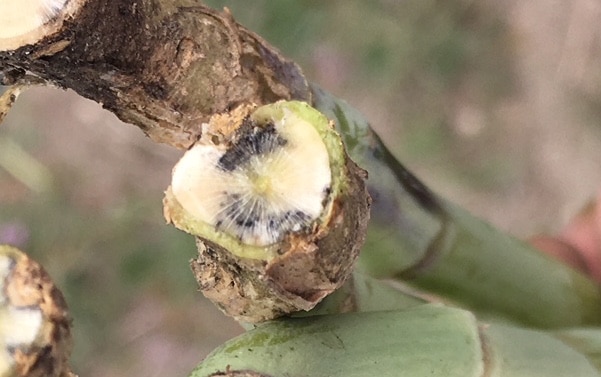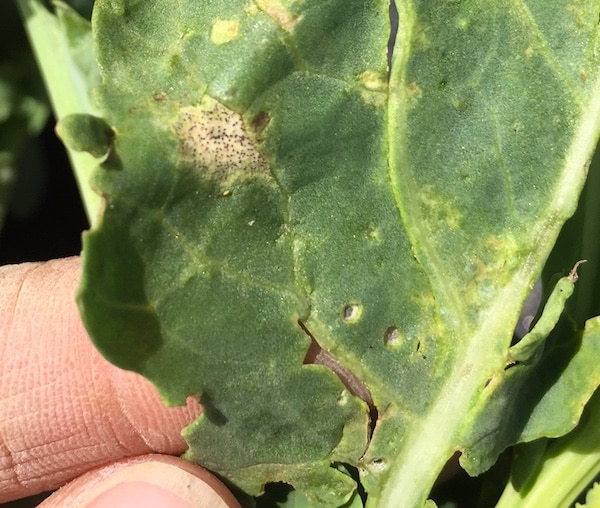Key Result
Researchers identified causative genes that provide adult plant resistance (APR) to blackleg. This quantitative trait provides more durable canola resistance against the blackleg pathogen Leptosphaeria maculans, particularly when combined with major race specific (qualitative) resistance genes.
Project Summary
Overview
Quantitative resistance to blackleg disease, also known as adult plant resistance (APR), is a quantitative trait controlled by multiple genes. It is a highly desirable trait for mitigation of risk to production and export of canola posed by the blackleg pathogen Leptosphaeria maculans (Lm). However the nature of APR genes and their function in providing protection is not known. The goal of this project is to combine gene expression profile and mapping data to identify genes providing immunity to blackleg of canola.

Identifying and deploying APR genes into B. napus is a pioneering approach that ensures long-term protection of canola against blackleg, thus improving profitability of canola production. In addition, gene specific markers will be a highly desirable tool for the canola seed industry to label canola varieties for presence and effectiveness of APR. APR labeling through the current approach that requires screening for APR, which relies on the screening of cultivars in blackleg field nurseries, is time consuming, expensive and inaccurate.
Researchers took advantage of the well-defined canola population that was created by crossing the B. napus cultivar Castle, which has APR to blackleg, and the B. napus cultivar Topas, which does not, to identify the quantitative trait locus (QTL) for blackleg resistance (BL-QTL). Unlike qualitative traits that are often controlled by single genes, QTLs such as crop yield are controlled by multiple genes.
Objectives
The objectives of this project are to clone adult plant resistance (APR) genes against blackleg disease, to characterize the host pathways triggered by these genes, and to incorporate APR genes into commercial canola cultivars by marker-assisted breeding and gene editing.
Results
Researchers developed a growth chamber APR screening method and tested the progenies of the Castle-Topas population for APR against blackleg. They identified a quantitative disease resistance trait and a major QTL locus candidate, named BL-QTL1 located on chromosome A08. This was the only QTL identified under the growth chamber APR assay and was also the most significant QTL under field conditions.
Building on previous APR genotyping efforts, the objectives of this four-year project were to identify and accurately map QTLs controlling APR, clone the QTLs, develop and test APR markers and understand the function and downstream pathways of APR.
Under growth chamber conditions, accurate mapping of QTLs combined with RNA-sequencing of individual progenies during response to L. maculans infection resulted in identification of several QTLs. Combining the mapping and gene expression data helped to identify several candidate QTLs with a high probability of controlling the APR response.
Researchers also evaluated BL-QTL performance under field conditions, and tested 53 spring type B. napus lines with a potentially functional BL-QTL1 trait in a blackleg field nursery in Alberta. Tests comparing 25 plants for each line in randomized replicated blocks. B. napus Castle and Westar, with and without APR respectively, were the controls.
At the end of growing season, researchers scored stem lesions on a 0 to 5 scale. Eleven lines showed APR to the same level or better than Castle, while in 18 lines the size of stem lesions was equal to or less than 60 per cent of the lesion size recorded for Westar.
As a result of the project, the discovery of quantitative resistance QTLs against blackleg, including the significant Bl-QTL1, is an important first step in understanding the molecular mechanism of QTL resistance. Canola breeders could use marker assisted selection to choose lines with this trait.
Going forward researchers will continue to investigate how to successfully apply the outcome of this research in designing canola cultivars with durable resistance to blackleg.






